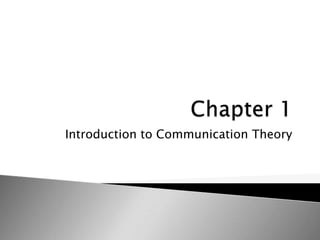Mba612 chapter 1
•Transferir como PPTX, PDF•
1 gostou•416 visualizações
This document provides an introduction to communication theory, defining it as a systematic summary about the nature of the communication process that focuses attention on concepts, clarifies observations, predicts behavior, and enables personal and social change. It distinguishes between commonsense, working, and scholarly theories, and identifies key criteria for evaluating theories including accuracy, practicality, succinctness, consistency, and acuity.
Denunciar
Compartilhar
Denunciar
Compartilhar

Recomendados
Recomendados
Mais conteúdo relacionado
Semelhante a Mba612 chapter 1
Semelhante a Mba612 chapter 1 (20)
Spectrum 2014-Communicating with Others – Research Says! Handout

Spectrum 2014-Communicating with Others – Research Says! Handout
AAAS 2018 Meeting Presentation: Science CommunicationTraining Landscape

AAAS 2018 Meeting Presentation: Science CommunicationTraining Landscape
Discussion Perception The Communication Process.docx

Discussion Perception The Communication Process.docx
The role of theory in researchProf Brian van WykPO.docx

The role of theory in researchProf Brian van WykPO.docx
Learning from discomfort - Science communication experiments between diffusio...

Learning from discomfort - Science communication experiments between diffusio...
Forte intro to theory book lesson 01 use theory for professional purposes po...

Forte intro to theory book lesson 01 use theory for professional purposes po...
Mais de Amy Jauman
Mais de Amy Jauman (8)
Último
Mehran University Newsletter is a Quarterly Publication from Public Relations OfficeMehran University Newsletter Vol-X, Issue-I, 2024

Mehran University Newsletter Vol-X, Issue-I, 2024Mehran University of Engineering & Technology, Jamshoro
Último (20)
Energy Resources. ( B. Pharmacy, 1st Year, Sem-II) Natural Resources

Energy Resources. ( B. Pharmacy, 1st Year, Sem-II) Natural Resources
Asian American Pacific Islander Month DDSD 2024.pptx

Asian American Pacific Islander Month DDSD 2024.pptx
Unit-IV; Professional Sales Representative (PSR).pptx

Unit-IV; Professional Sales Representative (PSR).pptx
Micro-Scholarship, What it is, How can it help me.pdf

Micro-Scholarship, What it is, How can it help me.pdf
On National Teacher Day, meet the 2024-25 Kenan Fellows

On National Teacher Day, meet the 2024-25 Kenan Fellows
ICT role in 21st century education and it's challenges.

ICT role in 21st century education and it's challenges.
Measures of Dispersion and Variability: Range, QD, AD and SD

Measures of Dispersion and Variability: Range, QD, AD and SD
Unit-V; Pricing (Pharma Marketing Management).pptx

Unit-V; Pricing (Pharma Marketing Management).pptx
Mba612 chapter 1
- 1. Introduction to Communication Theory
- 2. Everyday view of communication is the flow of information from one person to another. Communication: the process by which people interactively create, sustain, and manage meaning.
- 4. Communication competence: balancing effectiveness and appropriateness. ◦ Effectiveness: extent to which you achieve your goals in interaction. ◦ Appropriateness: fulfilling social expectations for a particular situation. Understanding theory will allow for a proper balance of effectiveness and appropriateness
- 5. Abstract understanding of communication process. Move beyond describing a single event by providing a means by which all like events can be described. Defined: systematic summary about the nature of the communication process. Functions include: ◦ Focusing attention on particular concepts ◦ Clarifying our observations ◦ Predicting communication behavior ◦ Generating personal and social change
- 6. Commonsense theory ◦ Theories-in-use ◦ Created through personal experiences ◦ Are often the basis for our decisions on how to communicate ◦ E.g.: Never date a colleague; it always ends up badly
- 7. Working theory ◦ Generalizations made in particular professions about the best technique for doing something ◦ More systematic than commonsense theory represent agreed-on ways of doing things in professions. ◦ E.g.: Audience analysis should be done prior to presenting a speech.
- 8. Scholarly theory ◦ Has undergone systematic research ◦ Provide more thorough, accurate, and abstract explanations for communication ◦ Typically more complex and difficult to understand ◦ E.g.: The media do not tell us what to think, but what to think about (agenda-setting theory)
- 9. Accuracy ◦ Correctly summarizes the way communication actually works ◦ Look at research studies that use the theory and see whether the research supports the theory or fails to support it.
- 10. Practicality ◦ How well the theory can be used to address real- world communication problems ◦ A theory with more applications is better than a theory without practical uses ◦ Look for how the theory has been used in the research literature as well as a theory’s professional application
- 11. Succinctness ◦ Is the theory formulated as simply as possible? ◦ Compare how much of communication is explained by the theory versus how many concepts are being used to explain it
- 12. Consistency ◦ The most useful theories have internal and external consistency ◦ Internal consistency means that the ideas of the theory are logically built on one another ◦ External consistency refers to the theory’s consistency with other widely accepted behaviors
- 13. Acuity ◦ The ability of a theory to provide insight into an otherwise intricate issue ◦ You need to think, “Wow, I never realized that!”
- 14. Case Study 1: Evaluating Groupthink ◦ How accurate is groupthink? ◦ How practical is groupthink? ◦ Is the theory appropriately succinct? Or is it overly simple or overly complex? ◦ Is groupthink consistent with other theories about group communication? Does it demonstrate internal consistency? ◦ Does groupthink demonstrate acuity?
- 15. Edward de Bono
- 16. The six thinking hats allows us to conduct our thinking as a conductor might lead an orchestra. We can call forth what we will.
- 18. • Neutral and objective • Concerned with objectives, facts and figures
- 19. • Cool… • Organization of thinking
- 20. • Cautious and careful • Points out the weaknesses in an idea
- 21. • The emotional view
- 22. • Creativity • Growth and new ideas
- 23. • Optimism • Hope and positive thinking
- 24. https://www.youtube.com/watch?v=smEqnnk lfYs Describe the “I Have a Dream” speech to a class of MBA students in Estonia.
